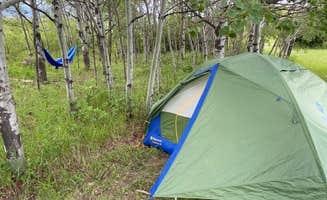Tent camping near Ekalaka, Montana offers primitive sites in the southeastern corner of the state, where elevations range from 3,400 to 3,700 feet. This remote area experiences extreme temperature variations, with summer highs often exceeding 90°F and winter lows frequently dropping below zero. The surrounding landscape features ponderosa pine forests interspersed with prairie grasslands and sandstone formations.
What to do
Fishing at nearby ponds: Macnab Pond provides a small fishing area approximately 5 miles northeast of Ekalaka where tent campers can enjoy catching trout during early mornings or evenings. The pond sits adjacent to several primitive camping spots with no formal designated sites.
Hiking to lookout points: The Lantis Spring Campground area offers hiking trails with elevation changes of 300-500 feet. As one visitor noted, "Very beautiful scenery" with "strong service at the top of hill before entering the campground and at the nearby fire look out."
Wildlife viewing opportunities: Wickham Gulch Campground provides tent campers with opportunities to observe deer, pronghorn antelope, and various bird species at dawn and dusk. The campground sits in a natural depression that concentrates wildlife activity, especially during morning hours.
Stargazing without light pollution: With minimal development in the region, the areas around South Sandstone Fishing Access Site offer exceptional stargazing opportunities. The site's location approximately 45 miles north of Ekalaka provides some of the darkest skies in the region, ideal for night sky photography during new moon periods.
What campers like
Natural spring access: At Lantis Spring Campground, campers appreciate having a natural water source nearby. One reviewer mentioned, "No electric or water, but a spring nearby for filtering water, established fire rings, and a very clean pit toilet."
Spacious, private sites: Many tent campers value the separation between sites. A camper at Ekalaka Park noted, "camping spots are very few but well spaced and comfortable for tents."
Minimal crowds even during peak season: The remote nature of these campgrounds ensures solitude. A Lantis Spring visitor reported, "You may even have some cow neighbors if you're lucky," highlighting the rural, uncrowded experience.
Hammock-friendly tree groves: Several sites offer stands of trees suitable for hammock camping. According to a recent visitor to Lantis Spring, "There's a few groves of trees for shade and hammocks and while my group managed to find spots that stayed shaded all day, some of the sites are very sunny."
What you should know
Road conditions vary seasonally: Access roads to most campgrounds are gravel and can become impassable after heavy rain or snow. A Lantis Spring camper noted, "The roads in were gravel but well maintained, didn't even have to put my vehicle into 4WD."
Limited or no cell service: Most tent camping areas near Ekalaka have minimal connectivity. A visitor to Lantis Spring reported, "I had 1 bar of cell service in the campground that came and went but strong service at the top of hill before entering the campground."
Fire restrictions change frequently: During dry periods, fire bans may be implemented with little notice. Always check current restrictions before camping.
Maintenance varies between sites: The condition of facilities fluctuates based on budget and staffing. A visitor to Ekalaka Park Campground observed, "Unfortunately a forest fire bordering the campground has led to it being nearly unusable. Maintenance is minimal."
Tips for camping with families
Choose sites with toilet facilities: For families with young children, prioritize campgrounds with maintained pit toilets. Lantis Spring Campground receives positive reviews for its "very clean pit toilet."
Bring games and activities: The remote location means no playgrounds or structured recreation areas. Pack cards, portable games, and nature identification guides.
Plan for temperature swings: Temperature variations of 30-40 degrees between day and night are common in this region. Pack appropriate clothing layers for children, especially for cool mornings.
Wildlife safety precautions: Teach children about keeping food properly stored and maintaining a safe distance from wildlife, particularly during early morning and evening hours.
Tips from RVers
Limited suitable sites for larger rigs: Most tent camping areas near Ekalaka accommodate small trailers or truck campers but present challenges for larger RVs. Sites at Macnab Pond and Ekalaka Park have terrain limitations that restrict larger vehicles.
No hookups available: All camping areas around Ekalaka are primitive with no electrical, water, or sewer connections. RVers must be fully self-contained and prepared for boondocking.
Gravel road access considerations: RVers should be prepared for 5-20 miles of gravel road driving to reach most campgrounds. As noted about Lantis Spring, the roads are "gravel but well maintained," though conditions can change seasonally.
Water availability limited to natural sources: No potable water exists at any sites, though some locations like Lantis Spring Campground offer natural springs for filtering: "a spring nearby for filtering water."


